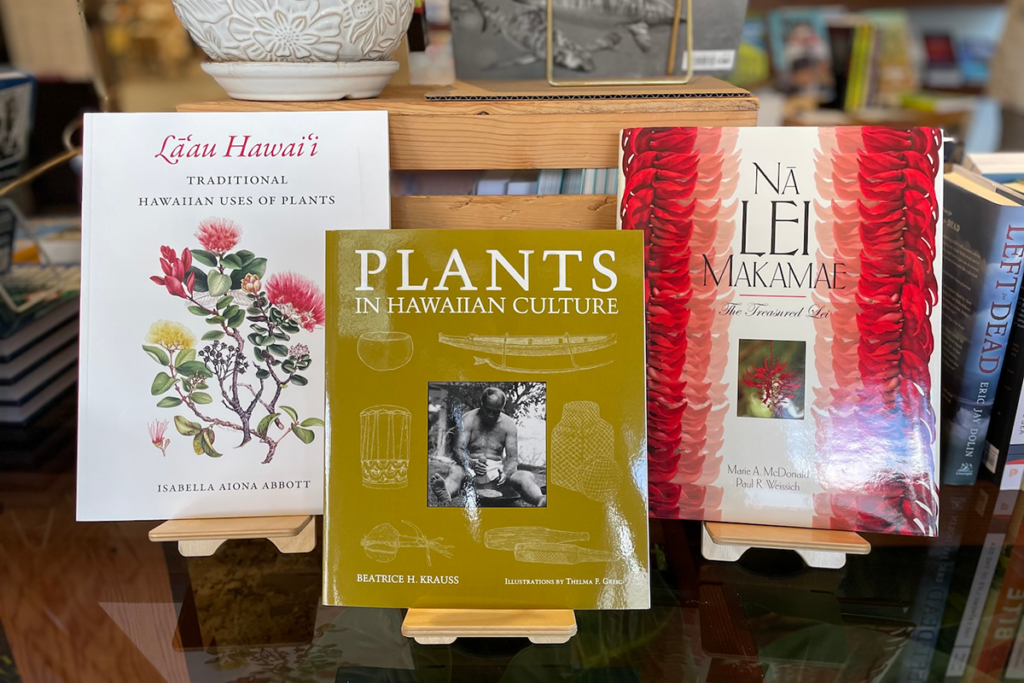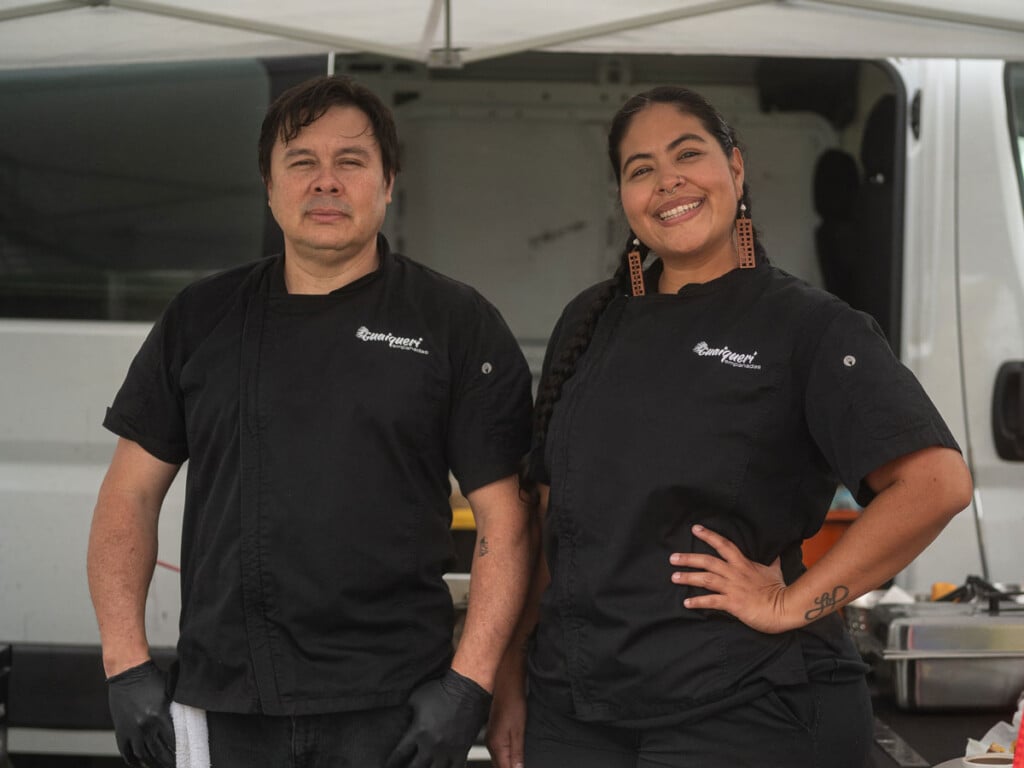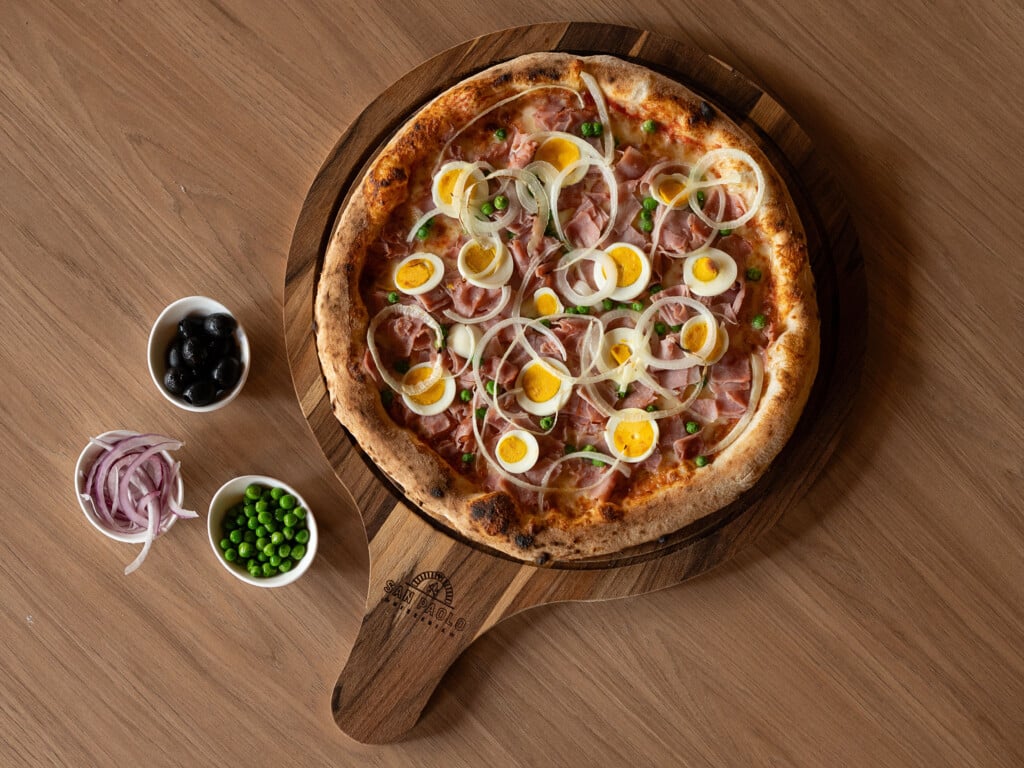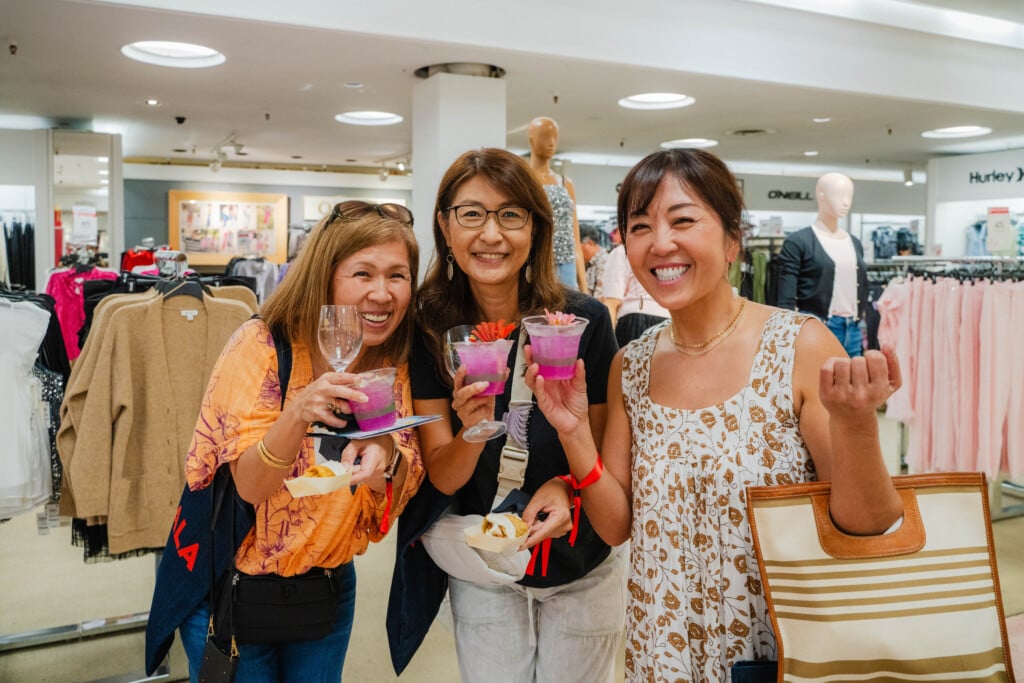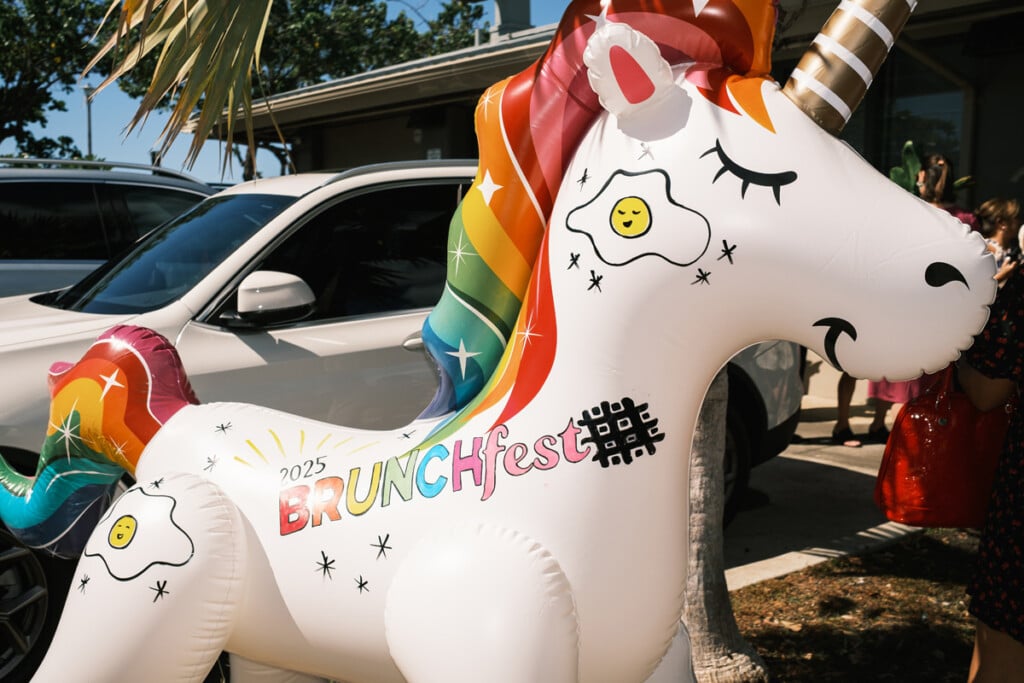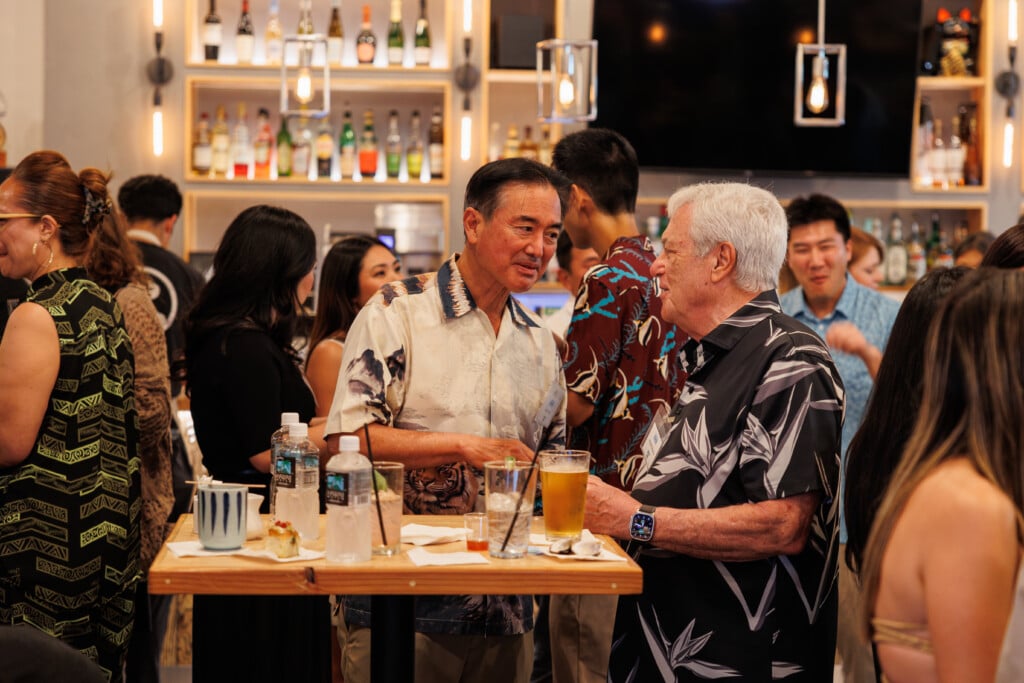Despite
being blessed by some of the best Hawai’i farmers and ranchers, despite being
the birthplace of Hawai’i regional cuisine, the Big Island has never really loomed
large in the Island dining scene. It’s always been a distant third to O’ahu and
Maui. That may be changing. Perhaps it’s no surprise that the Kona side
of the island-with its glittering array of expensive resorts-keeps producing interesting
restaurants. However, even Hilo is showing remarkable signs of culinary life. The
Big Island boasts more square miles than the rest of the Islands combined. It’s
hard to cover adequately from Honolulu, so I’d like to thank our food writer,
Joan Namkoong, for covering the Hilo scene, while I had the pleasure of hitting
the new Kona hotspots-and one Waimea hole-in-the-wall. On
The Kona Coast The
Huala-lai Grille by Alan Wong 100
Ka’üpülehu Drive,
Ka’üpülehu-Kona
(808)
325-8525 Lunch
11:30 a.m.-2:30 p.m., bar menu 2:30-9 p.m.,
dinner
nightly 5-9 p.m.
Valet
parking, major credit cards |
The biggest news from
the Big Island is that Alan Wong is back. It’s only been nine years since Wong
opened his eponymous Honolulu eatery, but many people have already forgotten that
he got famous first on the Big Island, at the Mauna Lani Resort. He’s back
at the scene of his earlier triumph, just down the road at Hualälai. Some explanation
of the venue: Although the valet parking is at the Four Seasons Resort Hualälai,
the restaurant belongs to the resort development company, not the hotel. It is,
in fact, the golf course restaurant, overlooking the 18th hole. “It’s not
my restaurant,” said Wong when I talked to him. “I am a consultant. We had to
change everything in a restaurant that had been running for five years, without
the ability to hire and fire staff. It was a challenge.” This restaurant is the
first of several joint Wong/Hualälai projects, including a restaurant reserved
for residents only, reminding you that the Kohala Coast has become a playground
for billionaires over the past decade. More and more of it is private. However,
you can just drive up and eat at the Hualälai Grille. They let me in, anyway.
Here’s what to expect: King Street, except nicer. It’s the dining room that’s
nicer-uncrowded, full of native woods, open to the air, tastefully decorated with
genuine Hawaiian artifacts. The young waiter had that direct Neighbor Island enthusiasm. The
menu, however, was classic King Street. Old favorites such as the spicy ‘ahi tartar
on avocado salsa or the wonderful tableside poke platter with tako, ‘opihi, ogo,
onion and sambal. (The right wine for these, which are spicier than expected,
is riesling. The house label riesling by the glass will do fine.) The Nakano
Farm tomato (blanched, skinned, quartered and reassembled) arrives on your table,
looking whole, with a sprig of basil on top and a pink li hing mui dressing on
the bottom. It looks like a Valentine’s Day present and tastes like summers past. There
was one entrée that, for the moment, was exclusive to Hualälai. It was chicken
from Shelton’s, an organic poultry farm in Southern California, served “two ways.”
There’s a grilled breast with a bit of bone in, and a leg served confit. The chicken
comes on top of a paella-style rice with Portuguese sausage, shrimp and clams.
Great flavors, a whole range of them, simply presented, but powerful in overall
effect. I’d go back to the Big Island to eat it again. (The best wine for this
seemed to be a pinot noir. There’s a rich, smooth one from Monterey producer Morgan,
by the glass.) For dessert you are back to classics, the five spoons of
crème brûlée and the Hawaiian chocolate crunch bars. This may be ho hum to you,
but I took a Big Island friend who’d never been to the O’ahu restaurant. “Oh my
god,” she said, tasting the chocolate bars. “Is it my birthday? Christmas?” The
food was so Alan Wong-like that I was not surprised when I wandered over to the
glassed-in display kitchen and saw the master himself and his sous chef Lance
Kosaka, both laboring on the hot line. At a table, and not in the kitchen, was
TV chef Ming Tsai. I stopped to say hello, asked him how he liked the restaurant.
“You can’t miss with Alan,” he said. Point taken. Merriman’s
Market Café Waikoloa
Beach Resort
Kings’ Shops
250 Waikoloa Beach Road
(808) 886-1700
Daily
11 a.m.-9 p.m.
Free parking, major credit cards |
It’s
hard to miss with Peter Merriman, as well. Merriman pioneered Hawai’i regional
cuisine in Waimea, in a restaurant that still thrives. He then went to Maui with
a big hit (Hula Grill) and a miss (Bamboo Bistro, which was probably in the wrong
location). He recently opened a second restaurant on the Big Island, and
it’s a great concept-a little Mediterranean-style market café and deli, completely
casual, the kind of place you can go for a sandwich or a meal. The food is fresh,
simple and direct, the mainly Mediterranean wine list is well-priced and interesting. There
are entrées and pastas, but I really loved the small dishes here. Roasted beet
salad with ricotta and Big Island arugula. There was bruschetta with caponata-good
bread, great local eggplant and imported olives. And tasty cheese platters with
an assortment of artisanal cheeses such as Maytag Blue or Humboldt Fog, plus figs
and dried currants. You have to love a place that not only makes its own
french fries (when was the last time you saw a handcut french fry?), but also
makes its own catsup, and, if catsup won’t do, puts a side of garlic aioli with
the fries, as well. We liked the wines, the house white (a Citra trebbiano
d’Abruzzo) and the a powerful rioja (Artadi Vinas De Gain Crianza). You can have
a full dinner with wine for two here and spend $40 each, but there’s no pressure
to eat a full meal. You can have a nice lunch for $10, or for about the same price,
a great snack and a glass of wine to pick up your afternoon. Honolulu needs
a Merriman’s Market Café. Maybe several: Ward, Hawai’i Kai, Kapolei, Kailua.
Brown’s
Beach House The
Fairmont Orchid Hawai’i
1 N. Kanikü Drive, Big Island
(808) 885-2000
Lunch
daily 11:30 a.m. to 2 p.m., dinner nightly 6-9:30 p.m. |
Brown’s
Beach House is one of those restaurants people fly all the way to Hawai’i to find.
Under the stars, steps from the shore, with live Hawaiian music under the tiki
torches, the discreetly illuminated surf rolling in in the near distance. It
seems almost too much to ask that the food be brilliant. But chef de cuisine Etsuji
Umezu pours wonders out of the newly renovated glassed-in display kitchen. Umezu
learned to cook in Japan, polished his craft all around the United States and
seems to have taken to Hawai’i regional cuisine like a master. It’s possible
to go on and on about his food, so let me confine myself to three examples. First,
there’s Kobe beef, marinated in garlic and green onions, seared lightly around
the edges, sliced and served with a citrus-soy sauce. Imagine ‘ahi tataki, but
with rare, virtually raw steak. The slices come out as soft as you’d expect Kobe
beef, but with just enough texture to make it interesting to eat. Standard American
beef is difficult to eat raw-it would have to be pounded flat, the way most chefs
make carpaccio. On the other hand, Kobe beef is perfect nearly raw. Cooked much,
it loses the fat that gives it its tenderness. Second, there’s an unagi
and fingerling potato salad. I’ve had very little luck describing this to people.
Somehow, the thought of potato salad with eel freaks them out. So give me some
conceptual space here. Umezu was working on a variation of uzaku, a traditional
Japanese eel and cucumber dish, when he happened upon an Italian cookbook belonging
to his boss, executive chef James Babian. There he discovered an Italian recipe
for eel and potato salad. He grabbed some fingerling potatoes from Waimea and
the rest is history-sort of. “Hardly anyone would order it,” recalls Babian.
“But the people who did were other chefs, so we knew it was good. We repositioned
it on the menu, and stayed with it.” It’s now served slightly warm, with
the tiny local potatoes and a bed of crisp cucumber. The eel (which the Japanese
eat for stamina in warm weather) is shaved so you hardly see it, just taste its
rich flavor. Add a little sea salt, a light soy vinaigrette, a few micro greens
and the whole thing is a tasty tribute to globalization. Finally, there’s
a dish that doesn’t need so much explanation, except for the name acqua pazza,
crazy water. It’s an Asian-style bouillabaisse with onaga in a fresh saffron clam
broth, topped with a little julienne ginger, light on everything except flavor. This
is, as you’ve probably figured out for yourself, high-end resort food. Dinner
for two can run nearly $200, even if, like me, you spot a bargain on the wine
list. I ordered a Chateau Routas, a French dry rose, which went perfectly with
the food, but cost less than $30. On the other hand, if you’re going to
splurge, this is a great place. Hawaiian
Style Café 64-1290
Kawaihae Road
Kamuela
885-4295
Breakfast
and early lunch Sunday 7:30-10:30 a.m., Monday-Friday 7:30-12:45 p.m., closed
Saturdays, the last Sunday and Monday of each month and all of September
Free
parking, no credit cards |
For years I’ve
been trying to eat loco moco at Waimea’s Hawaiian Style Café. Every trip to the
Big Island, I would stop by … and the café would be closed. Here’s the deal on
this 47-seat eatery in a dilapidated Waimea plantation-era building. Most weekdays,
it’s officially open until 12:45 p.m.-but it’s not, really, since, as the menu
warns: “Come early-closed early when food is gone.” On a busy day, it runs out
of food well before noon. Even when I learned to go early, it’s closed Saturdays,
the last Sunday and Monday of each month and all of September. Finally,
this trip, I finally arrived when it was open for business. “Hi, sweetie,” I said
to my friend, who was already sitting at the old-style wooden counter. “Hi,
yourself,” said the waitress. I looked up. “I’m a sweetie, too,” she said. True.
This particular sweetie turned out to be Amy Bendsten, who, for the past
dozen years, has owned the café with her cook/husband Mike. “You’re never open,”
I said. “Honey,” said Amy Bendsten, “I don’t see how that could be. It seems
to me I am always here.” After all the years of anticipation, I couldn’t
finish the loco moco at the Hawaiian Style Café. And I ordered the small. The
small loco moco is an entire pound of Big Island, forage-fed ground beef, served
on a plastic platter over rice with gravy, a heaping portion of grilled onions
and a fried egg. If you finish a large order of loco moco, which involves
two pounds of ground beef, you get a free side order of two 10-inch pancakes.
I don’t know if that constitutes a reward or punishment. In fact, we got
pancakes anyway, they came with the suitably massive barbecue local pork and onion
omelet. The pancakes, while not up to Boots & Kimo’s, are damn good. My
friend and I didn’t finish any of the food we ordered, but ended up in excellent
humor nonetheless. Amy and Mike seem to be doing exactly what they want, the way
they want to do it. The place is always packed, because the breakfasts, in addition
to being massive, are incredibly cheap-$6.25 for the loco moco. And the loco moco
is truly great-well, not the gravy, but the beef. The downside of forage-fed beef
is that the steaks tend to be tough. The upside is that the ground beef tastes
like steak. I love restaurants of every kind that know what they do and
do well. Hawaiian Style Café qualifies in that regard. Just make sure you’re hungry. Hilo
Restaurants The hottest spot for new restaurants right now is Hilo.
Yes, in sleepy Hilo, two restaurants are the talk of the town. Not just because
they are new to Hilo, but because they are as sophisticated in décor and food
as restaurants in San Francisco or New York.
Hilo
Bay Café Waiäkea
Shopping Center,
315 Maka’ala St., Hilo
935-6614
Monday-Saturday 11 a.m.-9
p.m. |
The Hilo Bay Café is tucked into the
food court of the Waiäkea Shopping Center. It was opened in October 2002 by Russell
Ruderman and Kim Snuggerud, the husband and wife owners of Island Naturals Market
and Deli in Hilo. Two employees of their natural food store, Joshua Ketner and
Darren Sakai, wanted to start a restaurant, and the couple decided to back them. The
décor and ambience of the restaurant are hardly typical for Hilo. “We wanted people
to be transported to San Francisco,” said Snuggerud. The color scheme’s sophisticated,
the furniture modern, the lighting informal and fun. Ketner is in charge
of the kitchen, a place he has been for 15 years, developing his style at various
locations. His menu is “upscale local,” but it’s really Asian, European and Hawaiian,
with French undertones. The flavors are light and bright, the menu is very inviting
and loaded with healthy sounding ingredients. A spanikopita filled with
potatoes alongside a nicely dressed spinach and sun-dried tomato salad was excellent.
Artichoke and parmesan dip served with crostini and broccoli for dipping was a
diet breaker, but worth it. Sakai runs the front of the house, where service
is hospitable and efficient; wine is also his forte, and Hilo Bay Café offers
a nice selection. The 65-seat café is sophisticated in a healthy way and
doesn’t compromise on taste and flavor. “This is not a sprouts kind of place,”
said Snuggerud. “A lot of natural foods people are disappointed. We’re serving
high-quality ingredients and organic when we can.” Just the kind of food we like. Kaikodo
60
Keawe St., Hilo
961-2558
Lunch Monday-Saturday 11 a.m. -2:30 p.m.,
dinner
Sunday-Thursday 5-9 p.m.,
Friday-Saturday until 10 p.m.,
Sunday Brunch
10:30 a.m.-2:30 p.m. |
Another dining
spot that’s worthy of a Hilo visit is Kaikodo, a well-appointed, upscale restaurant.
It lives up to its name, which translates to “hall embracing antiquity.” Owners
Howard and Mary Ann Rogers are art dealers who, several years ago, escaped from
the rigors of an office in Japan and gallery in New York by moving to Hilo. Asian
art is their business and their keen eye for remarkable pieces is evident in the
décor of their restaurant. They showcased Murano glass lighting, an antique mahogany
English bar and many Asian chests and other works of art in the old Toyama Building,
a historic Hilo landmark that once housed Roussell’s restaurant. One private dining
area, with a 200-year-old wall, is furnished like a Chinese bedroom. The Rogers
plan to exhibit art eventually in the building’s upper floors. Son Scott
Rogers manages the 90-seat restaurant that opened in May 2003. The kitchen is
run by Mike Fennelly, who picked up a James Beard nomination in the course of
a career that has taken him from Sante Fe to New Orleans to San Francisco. Fennelly
happened to be taking some time off in Hilo just as the Rogers decided to open
a restaurant. Fennelly’s menu is a marriage of East and West, employing
the bounty of produce available at the Hilo Farmers’ Market, fresh Island fish,
Hämäkua Coast products such as goat cheese and mushrooms, and even Mehana Red
Ale, brewed in Hilo. Flavors are juxtaposed. Crisp tofu with ponzu citrus
soy sauce plus jalapenos and seaweed. Oysters with Korean sauce and pancetta.
Goat cheese gnocchi with Chinese black vinegar sauce. A Chinese smoked tea duck
(a frequent special) is laced with chili sauce, ahi poke is seasoned with tamarind,
beets in a lovely goat cheese salad are flavored with ginger. It all works, subtly,
perhaps too subtly, needing a touch more flavor to really enliven the tastebuds. Kaikodo
has become the celebration destination for Hilo. The Rogers go all out with decorations
appropriate for holidays. Live jazz is featured on Wednesday evenings. Kaikodo’s
bar is the kind where you want to linger. The whole experience is destined to
put Hilo on the fine-cuisine-in-Hawai’i dining map. At last. |
